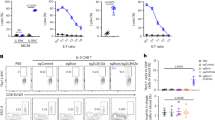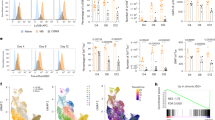Abstract
CLASS I and class II MHC-restricted T lymphocytes recognize non-native forms of antigen1–7. The presentation of antigen to these two classes of T lymphocytes can occur through distinct pathways8–10. Several mechanisms, including differences in antigen processing in different intracellular compartments, have been proposed to account for these pathway differences9–14. Here we describe a T-cell epitope located on the influenza virus haemag-glutinin, which is recognized by both class I and class II MHC-restricted cytolytic T lymphocytes (CTL). When expressed de novo in target cells, from a synthetic minigene15 encoding only the epitope, this pre-processed antigenic site is recognized by class I but not class II MHC-restricted T lymphocytes, even though target cells treated with the exogenously introduced peptide can be recognized by both classes of T cells. Because endogenous expression of the pre-processed antigenic fragment results in differential presentation to class I and class II MHC-restricted CTL, differences between the two different pathways of presentation could lie not at the level of processing but at the level of targeting and/or interaction of processed antigen with MHC.
This is a preview of subscription content, access via your institution
Access options
Subscribe to this journal
Receive 51 print issues and online access
$199.00 per year
only $3.90 per issue
Buy this article
- Purchase on Springer Link
- Instant access to full article PDF
Prices may be subject to local taxes which are calculated during checkout
Similar content being viewed by others
References
Ziegler, H. K. & Unanue, E. R. Proc. natn. Acad. Sci. U.S.A. 79, 175–178 (1982).
Unanue, E. R. A. Rev. Immun. 4, 395–428 (1984).
Townsend, A. R. M., Gotch, F. M. & Davey, J. Cell 42, 457–467 (1985).
Townsend, A. R. M. et al., Cell 44, 959–968 (1986).
Wabuke-Bunoti, M., Fan, D. P. & Braciale, T. J. J. Immun. 127, 1122–1125 (1981).
Maryanski, J. L., Pala, P., Corradin, G., Jordan, B. R. & Cerrotini, J. C. Nature 324, 578–579 (1986).
Gotch, F., Rothbard, J., Howland, K., Townsend, A. & McMichael, A. Nature 326, 881–882 (1987).
Morrison, L. A., Lukacher, A. E., Braciale, V. L., Fan, D. P. & Braciale, T. J. J. exp. Med. 163, 903–921 (1986).
Braciale, T. J. et al. J. exp. Med. 166, 678–692 (1987).
Moore, M. W., Carbone, F. R. & Bevan, M. J. Cell 54, 777–785 (1988).
Germain, R. N. Nature 322, 687–689 (1986).
Germain, R. N. Cell 54, 441–444 (1988).
Jin, Y., Shih, J. W.-K. & Berkower, I. J. exp. Med. 168, 293–306 (1988).
Jacobson, S., Sekaly, R. P., Jacobson, C. L., McFarland, H. F. & Long, E. O. J. Virol. 63, 1756–1762 (1989).
Sweetser, M. T., Braciale, V. L. & Braciale, T. J. J. Immun. 141, 3324–3328 (1988).
Braciale, T. J., Sweetser, M. T., Morrison, L. A., Kittlesen, D. J. & Braciale, V. L. Proc. natn. Acad. Sci. U.S.A. 86, 277–281 (1989).
Lukacher, A. E., Morrison, L. A., Braciale, V. L., Malissen, B. & Braciale, T. J. J. exp. Med. 162, 171–187 (1985).
Bennink, J. R., Yewdell, J. W., Smith, G. L., Moller, C. & Moss, B. Nature 311, 578–579 (1984).
Coupar, B. E. H., Andrew, M. E., Both, G. W. & Boyle, D. B. Eur. J. Immun. 16, 1479–1487 (1986).
Townsend, A. R. M., Bastin, J., Gould, K. & Brownlee, G. G. Nature 324, 575–577 (1986).
Gething, M.-J., McCammon, K. & Sambrook, J. Cell 46, 939–950 (1986).
Doyle, C., Roth, M. G., Sambrook, J. & Gething, M.-J. J. Cell Biol. 100, 704–714 (1985).
Lazarovits, J. & Roth, M. Cell 53, 743–752 (1988).
Nuchtern, J., Bonifacino, J., Biddison, W. & Klausner, R. Nature 339, 223–226 (1989).
Yewdell, J. W. & Bennink, J. R. Science 244, 1072–1075 (1989).
Blum, J. S. & Cresswell, P. Proc. natn. Acad. Sci. U.S.A. 85, 3975–3979 (1988).
Chakrabarti, S., Brechling, K. & Moss, B. Molec. cell. Biol. 5, 910–923 (1981).
Author information
Authors and Affiliations
Rights and permissions
About this article
Cite this article
Sweetser, M., Morrison, L., Braciale, V. et al. Recognition of pre-processed endogenous antigen by class I but not class II MHC-restricted T cells. Nature 342, 180–182 (1989). https://doi.org/10.1038/342180a0
Received:
Accepted:
Issue Date:
DOI: https://doi.org/10.1038/342180a0
This article is cited by
-
Immunodeficiency in Patients with Acute Exacerbation of Chronic Obstructive Pulmonary Disease
Inflammation (2018)
-
Multi‐epitope DNA vaccines
Immunology & Cell Biology (1997)
-
MHC ligands and peptide motifs: first listing
Immunogenetics (1995)
-
Processing pathways for presentation of cytosolic antigen to MHC class II-restricted T cells
Nature (1992)
-
Presentation of viral antigen by MHC class I molecules is dependent on a putative peptide transporter heterodimer
Nature (1992)
Comments
By submitting a comment you agree to abide by our Terms and Community Guidelines. If you find something abusive or that does not comply with our terms or guidelines please flag it as inappropriate.



